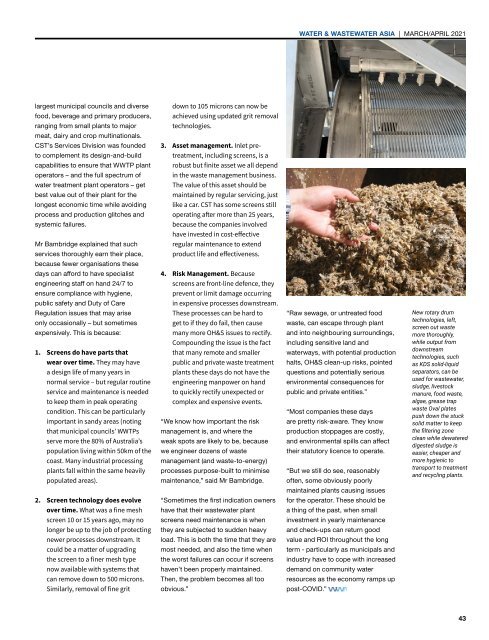Water & Wastewater Asia March/April 2021
Water & Wastewater Asia is an expert source of industry information, cementing its position as an indispensable tool for trade professionals in the water and wastewater industry. As the most reliable publication in the region, industry experts turn this premium journal for credible journalism and exclusive insight provided by fellow industry professionals. Water & Wastewater Asia incorporates the official newsletter of the Singapore Water Association (SWA).
Water & Wastewater Asia is an expert source of industry information, cementing its position as an indispensable tool for trade professionals in the water and wastewater industry. As the most reliable publication in the region, industry experts turn this premium journal for credible journalism and exclusive insight provided by fellow industry professionals. Water & Wastewater Asia incorporates the official newsletter of the Singapore Water Association (SWA).
Create successful ePaper yourself
Turn your PDF publications into a flip-book with our unique Google optimized e-Paper software.
WATER & WASTEWATER ASIA | MARCH/APRIL <strong>2021</strong><br />
largest municipal councils and diverse<br />
food, beverage and primary producers,<br />
ranging from small plants to major<br />
meat, dairy and crop multinationals.<br />
CST’s Services Division was founded<br />
to complement its design-and-build<br />
capabilities to ensure that WWTP plant<br />
operators – and the full spectrum of<br />
water treatment plant operators – get<br />
best value out of their plant for the<br />
longest economic time while avoiding<br />
process and production glitches and<br />
systemic failures.<br />
Mr Bambridge explained that such<br />
services thoroughly earn their place,<br />
because fewer organisations these<br />
days can afford to have specialist<br />
engineering staff on hand 24/7 to<br />
ensure compliance with hygiene,<br />
public safety and Duty of Care<br />
Regulation issues that may arise<br />
only occasionally – but sometimes<br />
expensively. This is because:<br />
1. Screens do have parts that<br />
wear over time. They may have<br />
a design life of many years in<br />
normal service – but regular routine<br />
service and maintenance is needed<br />
to keep them in peak operating<br />
condition. This can be particularly<br />
important in sandy areas (noting<br />
that municipal councils’ WWTPs<br />
serve more the 80% of Australia’s<br />
population living within 50km of the<br />
coast. Many industrial processing<br />
plants fall within the same heavily<br />
populated areas).<br />
2. Screen technology does evolve<br />
over time. What was a fine mesh<br />
screen 10 or 15 years ago, may no<br />
longer be up to the job of protecting<br />
newer processes downstream. It<br />
could be a matter of upgrading<br />
the screen to a finer mesh type<br />
now available with systems that<br />
can remove down to 500 microns.<br />
Similarly, removal of fine grit<br />
down to 105 microns can now be<br />
achieved using updated grit removal<br />
technologies.<br />
3. Asset management. Inlet pretreatment,<br />
including screens, is a<br />
robust but finite asset we all depend<br />
in the waste management business.<br />
The value of this asset should be<br />
maintained by regular servicing, just<br />
like a car. CST has some screens still<br />
operating after more than 25 years,<br />
because the companies involved<br />
have invested in cost-effective<br />
regular maintenance to extend<br />
product life and effectiveness.<br />
4. Risk Management. Because<br />
screens are front-line defence, they<br />
prevent or limit damage occurring<br />
in expensive processes downstream.<br />
These processes can be hard to<br />
get to if they do fail, then cause<br />
many more OH&S issues to rectify.<br />
Compounding the issue is the fact<br />
that many remote and smaller<br />
public and private waste treatment<br />
plants these days do not have the<br />
engineering manpower on hand<br />
to quickly rectify unexpected or<br />
complex and expensive events.<br />
“We know how important the risk<br />
management is, and where the<br />
weak spots are likely to be, because<br />
we engineer dozens of waste<br />
management (and waste-to-energy)<br />
processes purpose-built to minimise<br />
maintenance,” said Mr Bambridge.<br />
“Sometimes the first indication owners<br />
have that their wastewater plant<br />
screens need maintenance is when<br />
they are subjected to sudden heavy<br />
load. This is both the time that they are<br />
most needed, and also the time when<br />
the worst failures can occur if screens<br />
haven’t been properly maintained.<br />
Then, the problem becomes all too<br />
obvious.”<br />
“Raw sewage, or untreated food<br />
waste, can escape through plant<br />
and into neighbouring surroundings,<br />
including sensitive land and<br />
waterways, with potential production<br />
halts, OH&S clean-up risks, pointed<br />
questions and potentially serious<br />
environmental consequences for<br />
public and private entities.”<br />
“Most companies these days<br />
are pretty risk-aware. They know<br />
production stoppages are costly,<br />
and environmental spills can affect<br />
their statutory licence to operate.<br />
“But we still do see, reasonably<br />
often, some obviously poorly<br />
maintained plants causing issues<br />
for the operator. These should be<br />
a thing of the past, when small<br />
investment in yearly maintenance<br />
and check-ups can return good<br />
value and ROI throughout the long<br />
term - particularly as municipals and<br />
industry have to cope with increased<br />
demand on community water<br />
resources as the economy ramps up<br />
post-COVID.”<br />
New rotary drum<br />
technologies, left,<br />
screen out waste<br />
more thoroughly,<br />
while output from<br />
downstream<br />
technologies, such<br />
as KDS solid-liquid<br />
separators, can be<br />
used for wastewater,<br />
sludge, livestock<br />
manure, food waste,<br />
algae, grease trap<br />
waste Oval plates<br />
push down the stuck<br />
solid matter to keep<br />
the filtering zone<br />
clean while dewatered<br />
digested sludge is<br />
easier, cheaper and<br />
more hygienic to<br />
transport to treatment<br />
and recycling plants.<br />
43


















